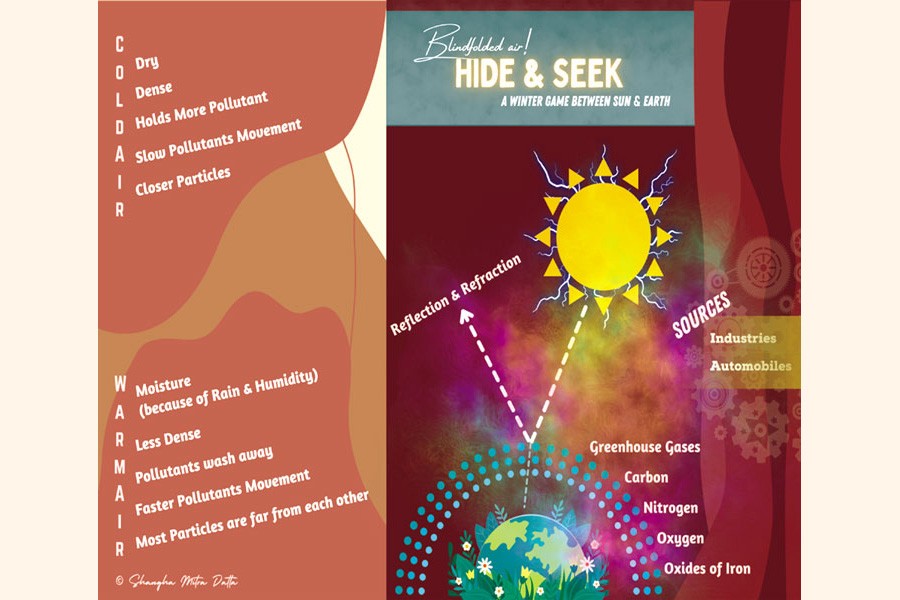Dim light reflects poor visibility, significantly deteriorating air quality in dense winter fog. Poor visibility and unhealthy air cause a meteorological emergency in winter over Dhaka and many other South Asian cities. Recently, World Bank, Dhaka reported that females are more stressed than males if they inhale bad-quality air. Children and older adults suffer more during winter in Bangladesh. The school absence rate for the children is also higher as the prevalence of respiratory and cardiovascular diseases increases during winter in Dhaka and other cities. If it matters for health, how do people ensure safety in this meteorological emergency?
Let's see why this country's winter is dark, dry, and foggy. Local and transboundary meteorology govern poor visibility in winter as the air near the ground becomes so thick that it harms public health. At this time, temperature inversion-- a natural process, occurs over a city that is potentially responsible for less light and bad air quality. Greenhouse gases are also equally causing loss of visibility. We all know that greenhouse gases and air particles absorb a portion of the light in the Earth's atmosphere. The significant light absorbers reported in the literature are ozone, methane, carbon dioxide, chlorofluorocarbon, nitrous oxide, nitrogen dioxide, black carbon, and other refractory materials. To make the story short, the above atmospheric compositions reduce the ambient light through the absorption of UV-visible light. So, the shiny sky turns dim. Another simultaneous process-- light reflection, occurs through a group of atmospheric compositions. This process is also significantly responsible for dimming the light in ambient air. As widely reported earlier in the literature, ammonium sulfate, ammonium nitrate, silicon dioxide, or sulfur dioxide can potentially scatter the incoming light from the sun back into space. Thus, we see less background light over the blue sky. Sometimes, haze or brown smog appears in the air.
The above changes in ambient air are entirely natural phenomena. Fundamentally, those are the reasons for poor visibility in the atmosphere. We are less responsible for making them happen but may limit the emission of those gases or particles. Governments are working closely under a newly formed umbrella, i.e., COP27, to restrict greenhouse gas emissions to meet the minimum of 1.5 C annual change in global temperature.
To make people more aware of the winter smoke, I must clarify the temperature inversion and its effect on alarming air pollution. Interestingly, the Earth emits a longer wavelength of invisible infrared radiation during night time that warms the air near the surface. The pollutants near Earth's surface usually drift to the upper atmosphere, making the air cleaner and healthier near the ground. However, a city like Dhaka experiences a temperature inversion during nighttime in which a shallow atmospheric layer appears a few hundred meters above the ground and has a relatively higher temperature than the upper and lower layers. So, the drift of the pollutants to upper atmospheric altitudes interrupts as the air becomes somewhat cooler near the surface and above the inversion layer. So, Dhaka and other cities in South Asia experience a thick blanket of air near the ground with a higher concentration of atmospheric compositions and water vapour which is very unhealthy for children and older adults. Thus, water vapour turns into thick fog or mist in the form of a droplet over the entire South Asian region during the early morning and nighttime. Daily life in the cities or even rural areas get potentially disrupted due to the winter fog. We walk on the street in the morning, feeling like we are walking on a cloud. Is it good or bad for our health? How about the health cost during this dense fog if it is bad?
The air pollutants are trapped in ambient air near the ground (outdoor and indoor apartments) during winter. This is a complete meteorological emergency in this region as the air quality deteriorates sharply. Additionally, there are polluted air plume transports from the northwestern part of Indo Gangetic Plain (IGP) in winter. Usually, there is enhanced biomass burning spotted over the entire IGP region. The farmers burn the agricultural residue in the farm land, causing smoke plumes over this region. Those natural phenomena and anthropogenic burning activities force people to inhale the thick air mixed with toxic substances. Those technical facts in air pollution have been reported in peer-reviewed international top journals by the "Aerosol Lab" at North South University, collaborating with BCSIR, Dhaka University, and Akita Prefectural University, Japan. Aerosol Lab emphasises the unknown sources of emerging pollutants, which pose significant health damage, particularly for children. This lab also works on the interaction of the pollutants with local scale meteorology that often triggers the deterioration of air quality.
A similar incident happened over London air, popularly known as "London's Killer Smoke 1952". The mixing height of air dropped to a few meters, making a thick smoke over London during 5-9 December 1952. This incident caused deaths to about 4000-5000 people just in five days in London. A group of scientists from Harvard University reported that the wild forest fire in Sumatra (Indonesia) caused huge smoke and claimed about 100,000.00 deaths in 2015 over Southeast Asia. Several organisations (World Health Organization, Heath Effect Institute etc.) reported air pollution, mainly indoor air quality, as a significant health concern for people in low-income countries. Until recently, the poor fuel quality added with anthropogenic burning is the identified reason for breathing polluted air. So, the above examples clarified that any air quality emergency could cause people's lives in the SA region. Should we be aware of winter smoke? Limiting outdoor activities and wearing face masks could be considered temporarily to mitigate this health emergency.
Md Firoz Khan, Ph.D is an Associate Professor and Leader of the Aerosol Labat North South University. He is former visiting professor at the China University of Mining & Technology, China, and senior lecturer at the University of Malaya, Malaysia.


